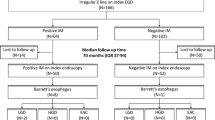Abstract
Background
A four-graded classification of the Z-line appearance (ZAP) has been proposed, which was shown to correlate with the prevalence of intestinal metaplasia (IM) among patients with gastroesophageal reflux disease (GERD). The aim of this study was to determine the ZAP grade and the prevalence of IM among patients without GERD.
Methods
In this study, 53 consecutive patients without signs or symptoms of GERD were included.
Results
A normal Z-line (ZAP grade 0) was found in 26 patients (51%), and this group had a lower prevalence of Helicobacter pylori infection and atrophy in the cardia than ZAP grade 1 patients. The non-GERD patients in this study had less ZAP pathology than the GERD patients in our previous study. Intestinal metaplasia at the Z-line, observed in 17% of the patients, was found to associate with peptic ulcer and carditis.
Conclusion
The normal Z-line is feasibly defined as ZAP grade 0.
Similar content being viewed by others
References
Carton E, Mulligan ED, Keeling PW, Tanner A, McDonald G, Reynolds JV (2000) Specialized intestinal metaplasia: analysis of prevalence risk factors, and association with gastroesophageal reflux disease. Br J Surg 87: 362–373
de Mas CR, Kramer M, Seifert E, Rippin G, Vieth M, Stolte M (1999) Short Barrett: prevalence and risk factors. Scand J Gastroenterol 34: 1065–1070
DeNardi FG, Riddell RH (1991) The normal esophagus. Am J Surg Pathol 15: 296–309
Hameeteman W, Tytgat GN, Houthoff HJ, van dTJ (1989) Barrett’s esophagus: development of dysplasia and adenocarcinoma. Gastroenterology 96: 1249–1256
Hirota WK, Loughney TM, Lazas DJ, Maydonovitch CL, Rholl V, Wong RK (1999) Specialized intestinal metaplasia, dysplasia, and cancer of the esophagus and esophagogastric junction: prevalence and clinical data. Gastroenterology 116: 277–285
Klauser AG, Schindlbeck NE, Muller-Lissner SA (1990) Symptoms in gastroesophageal reflux disease. Lancet 335: 205–208
Nandurkar S, Talley NJ, Martin CJ, Ng TH, Adams S (1997) Shortsegment Barrett’s esophagus: prevalence, diagnosis, and associations. Gut 40: 710–715
Price AB (1991) The Sydney System: histological division. J Gastroenterol Hepatol 6: 209–222
Richter JE (1998) Intestinal metaplasia and the squamocolumnar junction: what does it all mean? Gut 42: 604–605
Riddell RH (1996) The biopsy diagnosis of gastroesophageal reflux disease, “carditis,” and Barrett’s esophagus, and sequalae of therapy. Am J Surg Pathol 20: Suppl 1 S31-S51
Sampliner RE (1998) Practice guidelines on the diagnosis, surveillance, and therapy of Barrett’s esophagus. The Practice Parameters Committee of the American College of Gastroenterology. Am J Gastroenterol 93: 1028–1032
Savary M, Miller G (1978) The esophagus: handbook and atlas of endoscopy. Gassmann, Solothurn Switzerland, pp
Spechler SJ (1997) The columnar lined esophagus: a riddle wrapped in a mystery inside an enigma. Gut 41: 710–711
Spechler SJ, Goyal RK (1986) Barrett’s esophagus. N Engl J Med 315: 362–371
Voutilainen M, Farkkila M, Juhola M, Nuorva K, Mauranen K, Mantynen T, Kunnamo I, Mecklin JP, Sipponen P (1999) Specialized columnar epithelium of the esophagogastric junction: prevalence and associations. The Central Finland Endoscopy Study Group. Am J Gastroenterol 94: 913–918
Voutilainen M, Farkkila M, Mecklin JP, Juhola M, Sipponen P (2000) Classical Barrett esophagus contrasted with Barrett-type epithelium at normal-appearing esophagogastric junction. Central Finland Endoscopy Study Group. Scand J Gastroenterol 35: 2–9
Wallner B, Sylvan A, Stenling R, Janunger KG (2000) The esophageal Z-line appearance correlates to the prevalence of intestinal metaplasia. Scand J Gastroenterol 35: 17–22
Winters CJ, Spurling TJ, Chobanian SJ, Curtis DJ, Esposito RL, Hacker JF 3d, Johnson DA, Cruess DF, Cotelingam JD, Gurneg MS, Cattau EL, Jr. (1987) Barrett’s esophagus: a prevalent, occult complication of gastroesophageal reflux disease. Gastroenterology 92: 118–124
Author information
Authors and Affiliations
Additional information
Online publication: 2 May 2001
Rights and permissions
About this article
Cite this article
Wallner, B., Sylvan, A., Stenling, R. et al. The Z-line appearance and prevalence of intestinal metaplasia among patients without symptoms or endoscopical signs indicating gastroesophageal reflux. Surg Endosc 15, 886–889 (2001). https://doi.org/10.1007/s004640090025
Received:
Issue Date:
DOI: https://doi.org/10.1007/s004640090025




